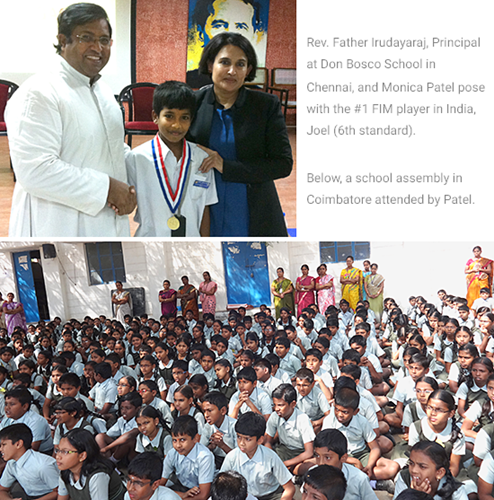MUMBAI, INDIA—CEO of First In Math India, Monica Patel, travels from her home in the United States to visit schools in her home country of India several times each year, and says that there are many common threads binding schools in India to schools in the U.S.
“Of course there are a few differences in terminology, as U.S. says MATH and India says MATHS, but there are many more similarities than differences,” explains Patel.

During her most recent trip, Patel visited schools in the north (Delhi, Haryana), west (Mumbai) and south (Bangalore, Chennai, Ooty and Coimbatore). Like the U.S., India is a huge country that has vast geographical and cultural variations native to each region. But because Maths is a universal language—the language of numbers—the First In Math program is a great way to make maths accessible to students across different geographies and cultures, says Patel.
Indian schools are charged with educating very diverse populations—just like in the U.S. There are students studying in government-aided schools as well as premier residential schools. The First In Math program shines in either environment, according to Ms. Sangita Chima, Headmistress of the Lawrence School. “Among all categories of schools the outpouring of love for First In Math and the lifelong love for learning maths it has created helps propel students toward success.” Just 15 months after launching FIM, students from Don Bosco Egmore and PSBB Chennai have already climbed to Top-10-School status and are home to many Top 10 Players.
As in some U.S. schools, there can be implementation challenges with an online-based program. “On this trip I was keen to know about the challenges that teachers face, and then share with them our best practices for implementation of FIM in their schools and classes,” says Patel, who quickly found that the number-one issue is simply connectivity (access to the internet).
In addition, most Indian schools are K-12 and have a large student body, so computer lab access is reserved for learning computer science and programming. To solve this problem, most schools mandate that FIM is done entirely at home—except in the case of #1-ranked school Don Bosco and the schools in Ooty—these are residential academies, where FIM can be used on campus.
Taking into account each school’s issues, Patel meets with school headmasters to share FIM Best Practices that work across the board when applied faithfully. These same practices are used in elementary schools across the U.S. “The number one factor contributing to success is using ‘Player of the Day’ to recognize every team’s top student each day,” explains Patel. Next is giving out milestone awards during weekly assemblies, to “take the focus away from the classroom and make it school pride. Children thrive on challenges and recognition—regardless of what part of the world they come from.”
Patel was somewhat surprised to learn that at first, many parents were fearful about their children accessing the Internet, but soon they were able to see that FIM was encouraging home practice and that their children were loving maths.
Along with parental involvement, full investment of all parties in the education process is key. “My most cherished memories are the culturally-rich school assemblies that I attend all over India,” says Patel. “Schools have daily or weekly assemblies; large gatherings of the entire student body are the norm. They are an exemplar of what the school community is truly about.”
Patel describes these assemblies as uplifting events, beginning with the national anthem and national pledge, and students reading one verse each from the Hindu Bhagavad Gita, Koran Sharif, and the Holy Bible. Then one group of students shares the world news, another shares the national news and one student will share regional headlines. Next, students are recognized for achievements in various curricular and extra-curricular activities, such as First In Math.
The assembly typically ends with the principal’s message, which is a call to action that focuses on the student’s role as a citizen. “This to me was the pure truth of what schooling should be about,” offers Patel. “As I heard one Principal say: School is the birthplace of the citizen.”